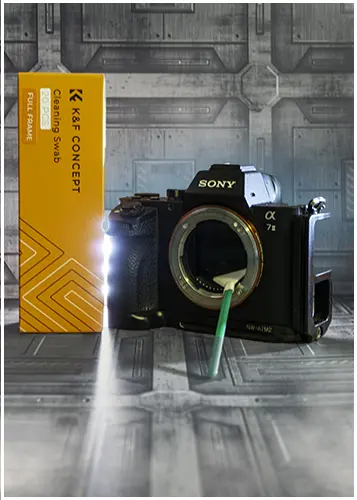
The Charming Northfield Falls in the Heart of Beach Estate Park
Looking to kill off an hour while in Nanaimo, BC? Just a short hop-skip and


As a photographer, you take great pride in capturing stunning images. But have you ever wondered if your camera sensor is hindering the quality of your shots? Dust and dirt on the sensor can cause visible spots, requiring hours of editing.
That’s why it’s crucial to learn the proper techniques. This post will show you how to clean your camera sensor, step by step.
You may have heard various myths and misconceptions about sensor cleaning, leading you to question its necessity or safety. But trust me, a clean camera sensor is essential. We’ll debunk common myths and provide guidance on safely removing dust and dirt.
So, are you ready to take control of your image quality and ensure that your camera sensor is squeaky clean? Let’s dive into our comprehensive camera sensor cleaning guide and discover the best practices for maintaining a dust-free sensor.
Over time, dust and dirt will accumulate on the sensor, leading to visible spots and blemishes in your photos. We’ll cover why keeping a sensor clean is important and how to tell when it needs to be cleaned.
Dust particles on the sensor can degrade the quality of your work. Regularly cleaning your camera helps keep your photos clean and reduces your editing time.
There are a few signs that indicate your camera sensor may need cleaning. Visible stains or blemishes may appear in your photographs, typically within regions of uniform colour such as the sky or a simple wall. You may also notice a decrease in image sharpness or an increase in noise levels, particularly at smaller apertures. If you encounter these issues, it’s a clear indication that your sensor requires cleaning.
Regularly inspect your photos at 100% zoom on your computer screen to accurately identify any sensor-related issues. If you notice consistent spots or artifacts across multiple images, it’s time to give your camera sensor a thorough clean.
Before you begin cleaning your camera sensor, it is essential to gather the necessary tools and equipment. Having the right tools will ensure a safe and effective sensor cleaning process.
Here is my list of essential tools:
Having these tools readily available will ensure that you are well-equipped to tackle any image sensor cleaning task, maintaining the clarity and quality of your captured images.
In addition to manual cleaning, many cameras offer a built-in sensor-cleaning mode. This mode utilizes internal mechanisms to vibrate or shake off dust particles from the sensor surface. Before performing manual cleaning, it is recommended to activate your camera’s sensor-cleaning mode to minimize the need for manual intervention, which could introduce lint.
To access and enable the sensor-cleaning mode, refer to your camera’s user manual or settings menu. The exact steps may vary depending on your camera model. Activating this mode periodically can help in maintaining a cleaner sensor and reducing the frequency of manual cleanings.
Now that you have gathered the necessary tools and are familiar with your camera’s sensor-cleaning mode, you are ready to proceed with the next step, the manual cleaning process. In the next section, we will provide a detailed step-by-step guide to manually cleaning your camera sensor.
Following these instructions will help you safely and effectively remove dust and dirt, ensuring optimal image quality.
Follow these methodical instructions to guarantee comprehensive and safe manual sensor cleaning, fostering the sustained high performance of your camera.
| Cleaning Tools | Use |
|---|---|
| Sensor swabs | Designed to safely clean the camera sensor surface |
| Cleaning solution | Aids in removing dust, smudges, and other contaminants |
| Sensor loupe or magnifying glass | It helps inspect the sensor for dust spots or smudges |
When using a swab, wipe in one direction and only use a swab once. Once done, throw out the swab
Pro-Tip
When it comes to maintaining the cleanliness of your camera sensor, sometimes manual cleaning may not be enough to tackle stubborn dirt or stains. In such cases, it’s essential to explore deep cleaning techniques that can effectively remove dirt and grime, ensuring optimal sensor performance. In this section, we will introduce you to the wet cleaning process and advanced options like gel sticks and sensor swabs.
The wet cleaning process is a more thorough method that involves using sensor swabs and cleaning solutions to deep clean your camera sensor. It is particularly useful for removing stubborn particles or stains that cannot be easily removed through manual cleaning alone.
To perform the wet cleaning process, you will need to carefully follow a step-by-step procedure that includes dampening the sensor swab with the appropriate cleaning solution, gently swiping the swab across the sensor surface, and then using a dry swab to remove any residue. It is crucial to use high-quality sensor swabs and cleaning solutions specifically designed for camera sensor cleaning to ensure safe and effective results.
In addition to the wet cleaning process, there are other advanced cleaning options available, such as gel sticks and sensor swabs. These alternatives provide alternative methods for effectively removing dirt and grime.
Gel sticks are soft, adhesive-like tools that attract and lift away dust particles from the sensor surface. They are gentle and easy to use, making them a convenient option for quick cleaning inside the camera. Sensor swabs, on the other hand, are specifically designed to reach the corners and edges of the sensor, ensuring thorough cleaning.
When using gel sticks or sensor swabs, it is crucial to carefully read and follow the instructions provided by the manufacturer. Choosing the right tool for your camera and applying the correct technique will help you achieve optimal cleaning results without causing any damage.
Proper routine maintenance is key to keeping your camera sensor dust-free and ensuring optimal performance.
Proper routine maintenance is key to keeping your camera sensor dust-free and ensuring optimal performance. Here are some essential tips to help you maintain a clean sensor:

Alternatives to DIY sensor cleaning
If DIY sensor cleaning doesn’t seem like the right option for you, there are alternatives available that can ensure a safe and effective cleaning process. One such alternative is hiring professional sensor cleaning services. Letting experts handle the cleaning can provide numerous benefits and give you peace of mind.
Despite your best efforts, there may be situations where professional sensor cleaning services are the best option. Consider the following scenarios:
By following these routine maintenance tips and knowing when to choose professional cleaning services, you can maintain a dust-free sensor and enjoy consistently high-quality images.
Professional sensor cleaning offers several advantages over DIY cleaning. Firstly, professionals have extensive experience and knowledge, allowing them to handle delicate camera sensors with care. They are familiar with different camera models and sensor types, ensuring they use the appropriate cleaning techniques and materials.
Moreover, professional cleaning services often have specialized equipment and tools that may not be easily accessible to consumers. These tools can help in achieving a more thorough and precise cleaning, resulting in a sensor that is free from dust, dirt, and lint.
Furthermore, professional sensor cleaning services typically offer a guarantee for their work. In the rare event that any damage occurs during the cleaning process, reputable service providers will take responsibility and cover the repairs or replacement costs.
When it comes to the cost of sensor cleaning, it is important to consider both the monetary and non-monetary aspects. While DIY cleaning may seem cost-effective initially, there are several factors to take into account.
With DIY cleaning, you will need to invest in sensor cleaning tools and solutions, which can add up over time. These tools may effectively clean the sensor, but they may not provide the same level of precision and effectiveness as professional-grade equipment.
Additionally, if any damage occurs during DIY cleaning, the cost of repair or replacement falls solely on you. This can be a significant expense, especially if delicate sensor components need to be repaired or replaced.
On the other hand, professional sensor cleaning services may have an upfront cost, but they can save you valuable time and potential repair expenses in the long run. With professionals, you can rest assured that the cleaning process will be carried out safely and efficiently, reducing the risk of damaging your camera sensor.
Ultimately, the decision between DIY cleaning and professional services comes down to your individual needs, budget, and level of confidence in performing the cleaning yourself. Assess your requirements and consider the benefits and costs associated with both options before making a decision.
| DIY Cleaning | Professional Services | |
|---|---|---|
| Cost | Initial investment in tools and solutions | Upfront cost for the service |
| Quality | May not provide the same level of precision. | Expert knowledge and specialized equipment |
| Responsibility | Repair or replacement costs are your responsibility | The service provider takes responsibility for any potential damage |
| Convenience | It requires time and effort | Time-saving option |
If you notice small dark spots or smudges on your images, there’s a high chance that your camera sensor has dust particles. These dust specks are more noticeable when you shoot with a small aperture and capture a bright background, such as a clear sky. Performing a visual inspection of your sensor or examining a test image at high magnification can help you confirm the presence of dust.
Yes, it is generally safe to clean your camera sensor at home as long as you follow proper techniques and use the right tools. Make sure to read your camera’s user manual for specific instructions on sensor cleaning and familiarize yourself with the cleaning process before attempting it inside the camera. It is also recommended to work in a dust-free environment and handle your camera and cleaning tools with care.
The frequency of sensor cleaning depends on how often you use your camera and the type of environment you shoot in. If you frequently change lenses or shoot in dusty or sandy conditions, you may need to clean your sensor more often. As a general guideline, it is recommended to check for dust regularly and clean the sensor when you start noticing visible dust spots or whenever image quality is affected.
When performed correctly and with the right tools, sensor cleaning should not damage your camera. However, there are potential risks associated with improper cleaning techniques or using non-recommended tools that may damage the image sensor. It is important to follow the manufacturer’s guidelines and exercise caution during the cleaning process. If you are unsure or uncomfortable with cleaning your sensor, it is advisable to seek professional sensor cleaning services to ensure the safety of your camera.

Looking to kill off an hour while in Nanaimo, BC? Just a short hop-skip and

Photography can be a fulfilling and enjoyable hobby that brings a creative outlet to your

Welcome to our guide to Photoshop tutorials for beginners: A Complete Beginner’s Tutorial for Learning